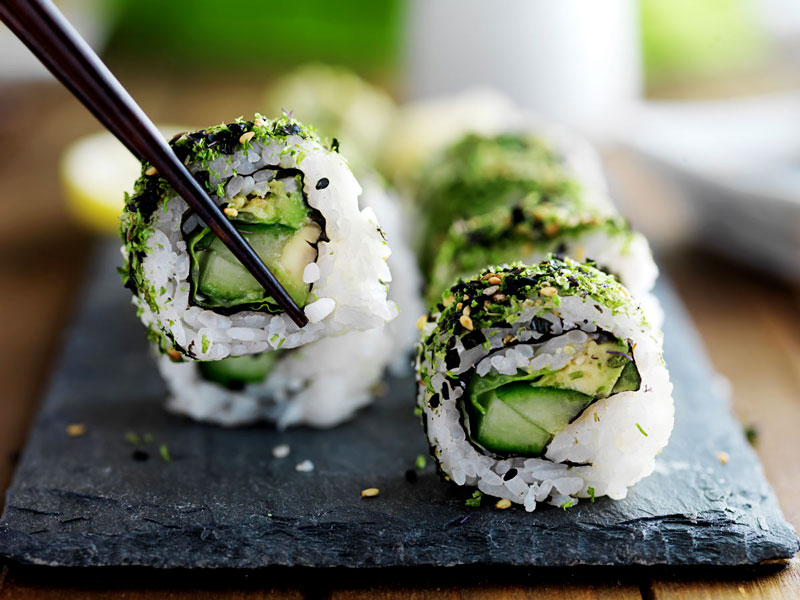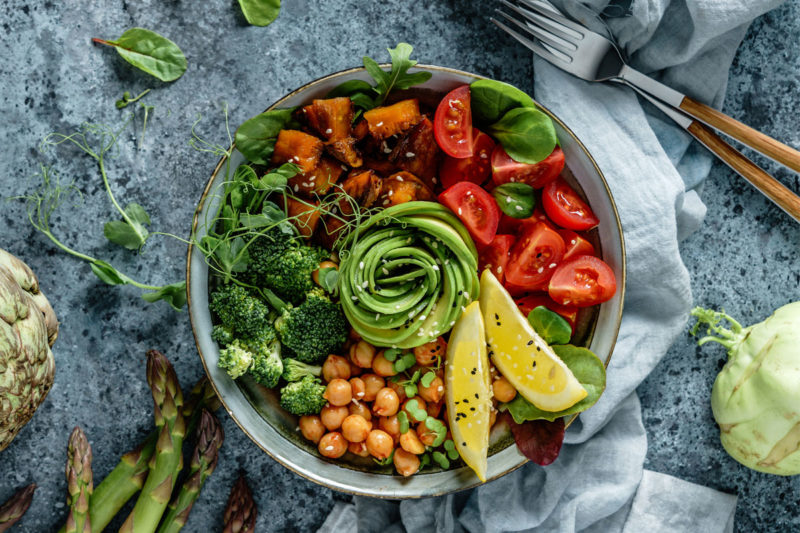For some, these food trends are about a healthy diet, eating healthily and responsibly. For others, they smack of a hint of restriction… So, slow food, raw food, vegan, organic, clean food – are they diets, or rather lifestyles?
Come on, let’s be honest, we are not always clear about what’s behind these fancy names, which promise a healthy diet and guilt-free food. But before embarking on one, or even several at once, or a combination, it’s essential to know what you’re getting into… Or rather, what you’re sinking your teeth into!
Clean Eating
As we have said before, Clean Eating is first and foremost about shunning processed foods, and instead favouring raw, local, seasonal foods that are free of additives and as fresh as possible. It’s a kind of back-to-our-roots approach, a return to farmers’ lore, illuminated by our current knowledge around health and nutrition.
This comes with the aim of never losing sight of the happy alliance between a healthy diet and pleasure. So let’s start with what makes sense. There can be no pleasure in eating without savouring your food, without awakening your senses: the greatest merit of the Slow Food trend.
Slow Food

Slow Food is more than a diet, it’s a lifestyle that has all the experts in agreement. Unanimously, nutritionists, naturopaths and dieticians sing the praises of eating slowly. In 1989, the opening of an umpteenth fast-food outlet in Rome irked the Italian food journalist Carlo Petrini, who let out a war cry that has since become an international organisation. Logically enough, slow food implies selecting foods carefully, and chewing them slowly in a relaxed atmosphere that is conducive to concentrating on savouring food.
By enjoying food in a mindful way that involves multiple senses, we not only allow the process of digestion to begin sooner but also assimilate vitamins and minerals better. As a result, we eat less (since the sensation of satiety comes on faster) and this is reflected in our weight. Without being labelled as a diet, slow food is your friend when it comes to watching your figure and keeping in shape.
- So in practical terms? With this approach, which is the opposite of fast food, everything is slow: start off by taking the time to select the distribution circuit of the groceries that you buy. Favour those that are sourced locally, of high quality and labelled organic. Take the time (again!) to cook with the contents of your healthy shopping basket. You get the idea – slow food has a processed foods intolerance. Only as a figure of speech, but even so. Anything that gets a disastrous score in the Nutriscore test (which quantifies how processed foods are) has no place on the shopping lists of slow food devotees. Next, take the time to get the dining area ready. Whether it’s at the table or on a picnic blanket, this lifestyle extends to pleasingly-arranged food and table setting. Obviously, slow food means not eating meals in front of the TV. Nor in a noisy environment, since stress causes muscle contractions and acid reflux. Perhaps you don’t have much time to cook? Schedule in a timeframe in the week to get ahead, favouring wholefoods and easy meal plans. The main thing is to stick to the principles previously outlined.
- In a nutshell: Slow food is aimed at fostering the art of eating healthy, locally-sourced, sustainable, natural food in accordance with biodiversity in mind. Intuitively, it has you switching everything to slow mode: life as we know it, but better!
Raw food

Does munching on healthy raw food make you a raw food diet fan? Only time will tell! Like any trend, this one might seem like a fad. Along with the boom in online yoga classes, in coaching about live, revitalising diets and the rising popularity of poké bowls, the raw food movement has gathered momentum very quickly. But what for? Again… It stands to reason. Cooking is all well and good. But cooking for too long, or using the wrong cooking method, destroys some or all of the nutrients. This is the argument central to this non-cooking of foodstuffs, from vegetables to some types of animal protein. Not everything is eaten raw, but cooking is done at no more than 42°, which is more of a gentle warming than cooking, which brings about changes in the foodstuff. This trend was born in the USA in the 1980s, and placed fruit and vegetables at the heart of its approach. At a time when fertiliser use threw caution to the wind, the raw-food diet went hand in hand with organic food.
- So in practical terms? Like slow food fans or Clean Eating devotees, buy produce sourced locally or with short supply chains, favouring quality and produce labelled organic. This makes sense, because when you skip the cooking, thus preserving nutrients and enzymes, you also retain some pollutants. The (organic) fruit and vegetables are to be eaten whole, freely offering up the antioxidants lodged in their peel. It’s not surprising that they are lodged there, since the peel protects against the sun’s rays, which are essential to the ripening process but are also to blame for oxidation. Next, mix it up by preparing them in different ways: put the fruit and vegetables through the juicer, the dehydrator, the food processor, grater, slicer, mandolin, yoghurt maker or germinator. This way you can make juices, crackers, natural crisps, compote, fruit and vegetable lasagne, sauerkraut, kimchi, kombucha and sprouted seeds. In summary, put together an endless range of dishes bursting with vitality (not surprising, as the raw food diet is a live food diet).
- In a nutshell: Eating raw food is a sustainable approach that favours zero pesticides, local sourcing and a seasonal diet. Though many raw food fans are vegetarians, those who are not switch between meat and fish carpaccios, sushi, sashimi and seafood. The only drawback is that this food trend looks uncannily similar to the eating habits of our distant ancestors holed up in their caves, without having the use of fire. Whereas our digestive system has since evolved and become unaccustomed to the all-raw diet. So… Now and always it’s a question of balance, switching between raw food and food cooked in the right way (at no more than 180°, steamed or in the wok). This is to go easy on the digestive system and microbiome. At any event, introduce raw foods into your routine gradually. But don’t drop (correctly) cooked foods completely.
Vegan

Did someone say vegan? Then let us explain. Turning vegan is often something done through conviction, when the realisation hits that the excessive industry around food from animal sources has reached its limits – at least its ecological limits, and for some its ethical ones too. Do you sometimes get vegan and vegetarian mixed up? That’s no surprise. Simply put, vegetarians eat neither meat nor fish nor seafood. For dietary vegans it’s out with meat, fish, seafood, eggs, and anything – yes, anything – that comes from an animal. That includes milk, honey, certain wines (those made using albumin from eggs, pork or beef gelatine, casein from milk, or isinglass: a kind of glue made from fish extract). As for ethical vegans, they take it further. They are consistent to the point of shunning other consumer items made using animal products. So out with wool, leather, wax and all products taken from hives, whether in clothing or beauty products
Veganism can be traced all the way back to the kind of vegetarianism advocated by Pythagoras and many other ancient Greek philosophers. More recently, Léonard de Vinci and Albert Einstein followed in their footsteps! Oh and then there are flexitarians, who are essentially vegetarian but do eat meat and fish… From time to time.
- So in practical terms? If you are vegetarian, you might embrace a variant of this approach by being ovo-lacto vegetarian (yes to eggs and milk), lacto-vegetarian (yes to dairy products but not eggs) or semi-vegetarian (yes to fish, seafood and for some, even white poultry meat). If you take it further and turn ethical vegan, do be aware that it’s not a diet, but a lifestyle rooted in ecological values. Don’t forget to take vitamin B12 supplements. However, to be on the safe side it’s best to have a blood workup to pick up any deficiency and determine the right dose to remedy it.
- In a nutshell: You protect the animal kingdom, take care of the planet and prevent the onset of cardiovascular disorders. You keep overweight at bay, not least by rounding out your diet with pulses and oilseeds high in essential fatty acids, and by favouring high-quality fruits and vegetables. If you’re invited over for a meal in someone’s else’s home, just don’t forget to warn the cook upfront so that they don’t put any off-limits animal protein on the menu.
Gluten free

For some, it is vitally imperative to eat a gluten-free diet, owing to a true allergy. In that case, a diet suited to those with coeliac disease (an autoimmune disorder of the intestine caused by gluten intolerance) is a must. So out with gluten. But what is it, anyway? It gets its name from glutinum: the Latin for link, or glue. It’s a substance formed when flour (essentially wheat flour, but also that of other cereals like barley and rye) containing its constituents is mixed with water and kneaded into dough. When water is added, a substance forms as a result of two protein types (gliadins and glutenins) coming together. It can be said that gluten makes itself. When we talk about gluten in general terms, we are really referring to wheat gluten, which has specific features.
Because this is the only type of gluten that, once kneaded into dough with water, gives it this elasticity, meshing of bonds and resulting stability. However, those with a gluten intolerance (coeliac disease or hypersensitivity) experience a reaction when exposed to one or both of the gluten’s constituent proteins. So what symptoms do they have? Digestive complaints, bloating, abdominal pain, and also chronic fatigue (exacerbated by intake of gluten-containing foods) and weight loss. To confirm or rule out coeliac disease as a diagnosis, a blood workup is carried out to isolate the immunoglobulin antibody (IgA).
- So in practical terms? OK, listen up now, as it’s up to you to play detective. Because even when products do contain gluten, it does not systematically appear on the ingredients list. Conversely, an increasing number of brands are marking out products that are gluten free with a crossed-out wheat head logo. This logo can be trusted, since it was filed (for France) by the French association of gluten intolerants [Association Française Des Intolérants Au Gluten – AFDIAG]. The situation is not easy to navigate, since gluten is contained in cakes, most breads and types of pasta, grits, beer, some cheeses, dried figs (which are often rolled in flour!), mass-produced pre-cooked meals (flour is used to bind and thicken sauces) and even cured meats. When it comes to alternative flours, take your pick from rice, oat, sorghum, millet or maize. Beware of barley, however. Although free from gluten as such, it is made up of proteins with a structure identical to gluten proteins and triggers the same intolerances. That said, if there’s nothing to indicate that you have an intolerance, there’s no point in embarking on a gluten free diet, which is more complicated and often more costly than a clean, organic or slow food approach. In fact, only 1% of the population suffers from coeliac disease. If you are diagnosed with it, you will be advised to take probiotic supplements to help alleviate the intestinal problems. It’s essential to get the guidance of a gastroenterologist, nutritionist or naturopath.
- In a nutshell: Listen to your body, especially your second brain (the intestine), which will show you any signs of an intolerance. Next, if it’s confirmed that you need to cut out gluten, head to the AFDIAG website to keep up with developments relevant to you. If you find out that you have an intolerance, cut out lactose too (even temporarily). Because if the intestine’s mucous membrane is irritated by gluten, its tolerance of lactose is reduced.
Organic
Whether you’re a gluten free devotee, taken with clean eating, into slow food or just convinced that eating healthily is a necessity, you almost instinctively get there via the organic aisle. Organic foods and crops are produced without the use of any artificial fertilisers or pesticides. As for organic farming, it’s always done without chemicals that are known to be toxic to human health, and mostly in an ethically-sound way, in accordance with the changing seasons. This diet brings with it not only a pared-down selection of organic distributors, but also consistent lifestyle choices. The organic way of life is about aligning your shopping basket with your life. The slight drawback (often mentioned by consumers) is that organic versions are more costly. They are also not sold in all shops, even though the number of dedicated aisles is increasing in all grocery stores, aside from those given over fully to organic products.

Food labels matter – those indicating what the ingredients are, the Nutriscore and other nutritional information. However, beware of labels that you buy into under the guise of a diet or trend.
Keep your eyes open, try things out, get acquainted with new things, be inventive and stay focussed on eating a diet that’s healthy, balanced, ethically sound and pleasurable.
Clean and happy, we tell you!







